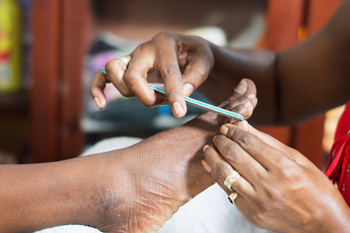
Foot drop occurs when the peripheral nerves controlling the feet become compressed or damaged. This can happen from a neurological problem, such as multiple sclerosis or a stroke, or a nerve issue. Those with diabetes, a herniated disk, or calcium deposits in the spine are more apt to develop foot drop. Sitting cross-legged or kneeling for prolonged periods, as well as injury or surgery involving the knee, hip, or lower back, can contribute to this condition as well. Foot drop can cause weakness and paralysis in muscles that pull the foot toward the shin, in addition to walking difficulties. This affliction can come on gradually or suddenly. Precursors include one shoe feeling looser than the other and the foot being difficult to lift, walking with a higher step, or one foot feeling weaker or numb compared to the other foot. Ankle and foot braces, exercises, nerve stimulation, and surgery can help with this condition. If you have problems with your feet and suspect foot drop, it is strongly suggested that you visit a podiatrist for a proper diagnosis and to get treatment underway.
Ankle pain can be caused by a number of problems and may be potentially serious. If you have ankle pain, consult with Terri Quebedeaux, DPM from Agave Podiatry . Our doctor will assess your condition and provide you with quality foot and ankle treatment.
Ankle pain is any condition that causes pain in the ankle. Due to the fact that the ankle consists of tendons, muscles, bones, and ligaments, ankle pain can come from a number of different conditions.
Causes
The most common causes of ankle pain include:
- Types of arthritis (rheumatoid, osteoarthritis, and gout)
- Ankle sprains
- Broken ankles
- Achilles tendinitis
- Achilles tendon rupture
- Stress fractures
- Bursitis
- Tarsal tunnel syndrome
- Plantar fasciitis
Symptoms
Symptoms of ankle injury vary based upon the condition. Pain may include general pain and discomfort, swelling, aching, redness, bruising, burning or stabbing sensations, and/or loss of sensation.
Diagnosis
Due to the wide variety of potential causes of ankle pain, podiatrists will utilize a number of different methods to properly diagnose ankle pain. This can include asking for personal and family medical histories and of any recent injuries. Further diagnosis may include sensation tests, a physical examination, and potentially x-rays or other imaging tests.
Treatment
Just as the range of causes varies widely, so do treatments. Some more common treatments are rest, ice packs, keeping pressure off the foot, orthotics and braces, medication for inflammation and pain, and surgery.
If you have any questions, please feel free to contact our offices located in Seguin, LaVernia, Gonzales, and Lockhart, TX . We offer the newest diagnostic and treatment technologies for all your foot care needs.









